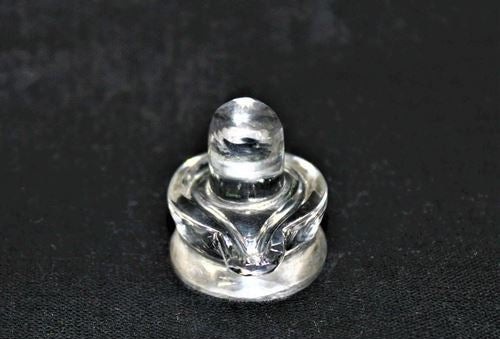The Sphatik Lingam holds a special place in Hindu worship, especially in the worship of Lord Shiva. Made from natural quartz crystal (sphatik), it is believed to bring spiritual energy, mental clarity, and positivity into homes and temples. However, due to their rising demand, many fake or artificial Sphatik Lingams are sold in the market. To ensure authenticity, it is essential to know how to identify an original Sphatik Lingam before purchase.

1. Understanding Sphatik Lingam
- The Sphatik Lingam is made from pure quartz crystal, a naturally occurring mineral known for its transparency and clarity.
- It is typically clear, colorless, or slightly milky, with a smooth, polished surface.
- Unlike artificial or glass Lingams, natural sphatik has unique internal patterns, inclusions, or small cracks, which are a sign of authenticity.
2. Physical Characteristics of Original Sphatik Lingam
a) Transparency and Clarity
- Genuine Sphatik Lingams have high clarity, but they are not perfectly transparent like glass.
- Look for natural inclusions, tiny air bubbles, or faint cloudy areas within the crystal. These are signs of natural formation.
- Fake Lingams made of glass or synthetic resin are often too clear or perfectly uniform, which is unnatural.
b) Weight and Density
- Original sphatik is dense and relatively heavy compared to its size.
- Fake or glass Lingams may feel lighter or hollow, lacking the solid feel of real quartz.
c) Temperature Sensitivity
- Sphatik has thermal stability. It feels cool to the touch even in warm conditions and warms slowly when held.
- Artificial materials like plastic or resin heat up quickly and lack the same cooling property.
d) Surface and Polish
- Authentic sphatik is smooth and finely polished, but not glossy like plastic.
- Look for even polish without scratches or unnatural shine.
- Fake Lingams may have a plastic-like shine or uneven polish.
3. Tests to Verify Originality
a) Scratch Test
- Quartz is hard (7 on Mohs scale).
- Gently try scratching the surface with a steel pin on an inconspicuous spot.
- If it scratches easily, it is likely fake or made of softer material.
b) Water Test
- Place the Lingam in water.
- Genuine Sphatik Lingam is heavier and sinks quickly, while fake Lingams made of resin or plastic may float or move unnaturally.
c) Light Test
- Shine a light through the Lingam.
- Original Sphatik refracts light gently and evenly, showing internal inclusions naturally.
- Artificial Lingams may refract light unnaturally or appear completely transparent without any imperfections.
4. Quick Practical Tips for Identification
| Feature | Original Sphatik Lingam | Fake Lingam |
| Transparency & Clarity | Clear with natural inclusions | Too perfect, completely clear |
| Weight & Density | Heavy and solid | Light or hollow |
| Temperature Sensitivity | Feels cool, warms slowly | Heats up quickly |
| Surface & Polish | Smooth, natural shine | Plastic-like, uneven polish |
| Hardness | Hard, cannot scratch easily | Soft, scratches easily |
| Light Refraction | Natural refraction with inclusions | Unnatural or uniform refraction |
5. Precautions When Buying
- Buy from trusted shops, temples, or verified online retailers.
- Request a certificate of authenticity or proof of natural quartz origin.
- Avoid Lingams that are excessively cheap, as genuine sphatik crystals are naturally valuable.
- Observe subtle imperfections and internal patterns, which are indicators of a natural Sphatik Lingam.
6. Final Thoughts
Identifying an original Sphatik Lingam requires careful observation of clarity, weight, temperature, surface, and light refraction. Genuine Sphatik Lingams are made of natural quartz crystal, heavier, cool to the touch, and have subtle internal inclusions that differentiate them from artificial versions. By following these guidelines, devotees and collectors can ensure that they purchase authentic Sphatik Lingams, preserving both spiritual value and financial investment.